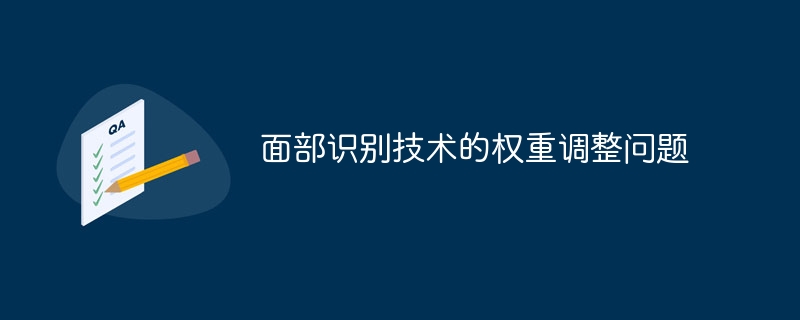

Facial recognition technology is a popular research direction that has attracted much attention in the field of artificial intelligence in recent years. It uses computer vision and pattern recognition technology to achieve automatic recognition and authentication of faces by analyzing features in face images. However, in practical applications, facial recognition technology still faces some challenges, one of which is the weight adjustment problem.
Weight adjustment means that in facial recognition technology, the weights of different features in the feature extraction process can be adjusted. Correctly adjusting feature weights can improve the accuracy and robustness of facial recognition. Incorrect or inappropriate adjustment of feature weights can cause the facial recognition system to lose accuracy or even produce erroneous recognition results. Therefore, the weight adjustment problem is crucial in facial recognition technology.
To solve the weight adjustment problem, we first need to choose a suitable optimization algorithm. Common optimization algorithms include genetic algorithms, simulated annealing algorithms, particle swarm optimization algorithms, etc. These algorithms can find the optimal weight configuration through iterative optimization. When selecting an optimization algorithm, factors such as the complexity, convergence performance, and adaptability of the algorithm need to be considered to ensure the effect of weight adjustment.
Taking the genetic algorithm as an example, a simple code example is given below:
import numpy as np
# 初始化种群
def init_population(pop_size, feature_num):
population = np.random.rand(pop_size, feature_num)
return population
# 适应度函数,评估个体的适应度
def fitness_func(population):
fitness = np.sum(population, axis=1)
return fitness
# 交叉操作
def crossover(parents, offspring_size):
offspring = np.empty(offspring_size)
crossover_point = np.uint32(offspring_size[1] / 2)
for k in range(offspring_size[0]):
parent_1_idx = k % parents.shape[0]
parent_2_idx = (k+1) % parents.shape[0]
offspring[k, 0:crossover_point] = parents[parent_1_idx, 0:crossover_point]
offspring[k, crossover_point:] = parents[parent_2_idx, crossover_point:]
return offspring
# 变异操作
def mutate(offspring_crossover):
for idx in range(offspring_crossover.shape[0]):
random_value = np.random.uniform(-1.0, 1.0, 1)
offspring_crossover[idx, :] = offspring_crossover[idx, :] + random_value
return offspring_crossover
# 主函数
def main():
pop_size = 10 # 种群大小
feature_num = 100 # 特征数量
num_generations = 100 # 迭代代数
offspring_size = (pop_size - pop_size % 2, feature_num) # 子代数量
population = init_population(pop_size, feature_num) # 初始化种群
for generation in range(num_generations):
fitness = fitness_func(population) # 计算适应度
parents = population[np.argsort(fitness)[-pop_size//2:], :] # 筛选优秀个体
offspring_crossover = crossover(parents, offspring_size) # 交叉操作
offspring_mutation = mutate(offspring_crossover) # 变异操作
population[0:parents.shape[0], :] = parents
population[parents.shape[0]:, :] = offspring_mutation
best_solution_idx = np.argmax(fitness_func(population)) # 找到适应度最高的个体
best_solution = population[best_solution_idx, :] # 提取最优解
print("最优解权重:", best_solution)
if __name__ == "__main__":
main()The above code is a simple genetic algorithm example, used to solve the weight adjustment problem in facial recognition technology. In the code, the population is first initialized and individual fitness is calculated, and then the next generation of individuals is generated through crossover and mutation operations, and the population is updated. Finally, find the individual with the highest fitness as the optimal solution.
It should be noted that the above code is for demonstration purposes only, and may need to be modified and optimized according to specific problems in actual applications. At the same time, other optimization algorithms can also be applied to weight adjustment, and the appropriate algorithm can be selected and adjusted according to specific needs.
To sum up, the weight adjustment problem of facial recognition technology is a key issue that needs to be solved in practical applications. Through appropriate optimization algorithms and appropriate adjustment strategies, the performance and accuracy of facial recognition technology can be improved, laying the foundation for better facial recognition applications. At the same time, for different problem scenarios, it is necessary to select the appropriate adjustment method according to the specific situation, and carry out corresponding optimization and improvement.
The above is the detailed content of Weight adjustment problem of facial recognition technology. For more information, please follow other related articles on the PHP Chinese website!




